After my initial post about the setup of this campaign a lot testing has been done. I started my first test run which led to a battle at Ceva with more than 3:1 odds for the French. The battle itself was fought with General d’Armee and was still interesting to play but I noticed that I am biting off to much, again. My campaign movement mechanisms need testing not the battles. After packing the game away I scrapped the first test run and looked for inspiration in boardgames and wargames how to simulate campaign battles. I found and tweaked something easy working with manpower and commander ability.
Test Run 2
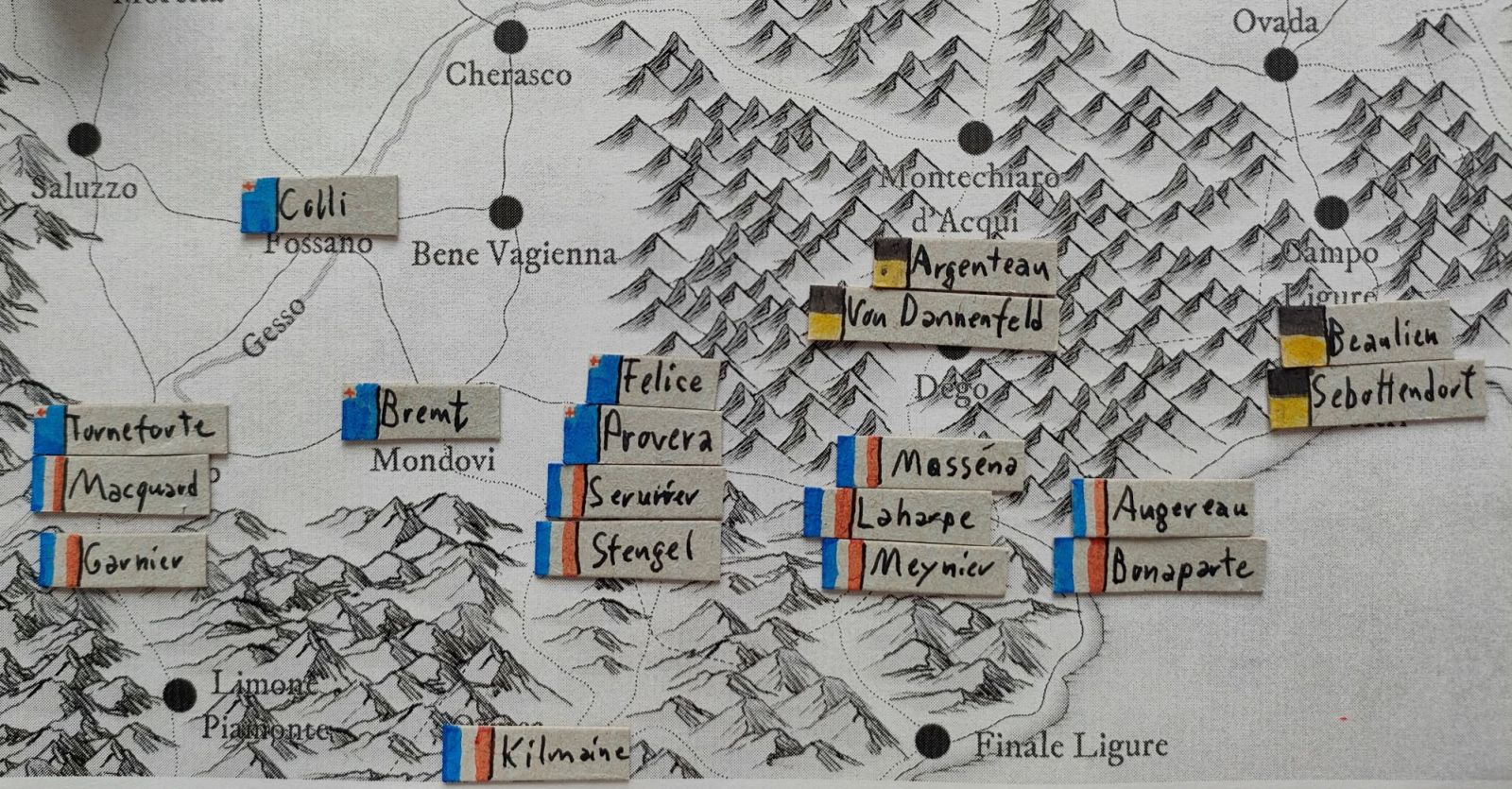
This run used the historical deployments and somewhat historical plans. Beaulieu threatens the French right while Colli’s Sardinians are engaged heavily.

At the end of day 3 the Sardinians suffered heavy losses at Mondovi and Ceva. An Austrian attack at Carcare failed miserably and to the right French forces are advancing as well. Some of the battles were relatively even in manpower but the French have better command and rolled very well.
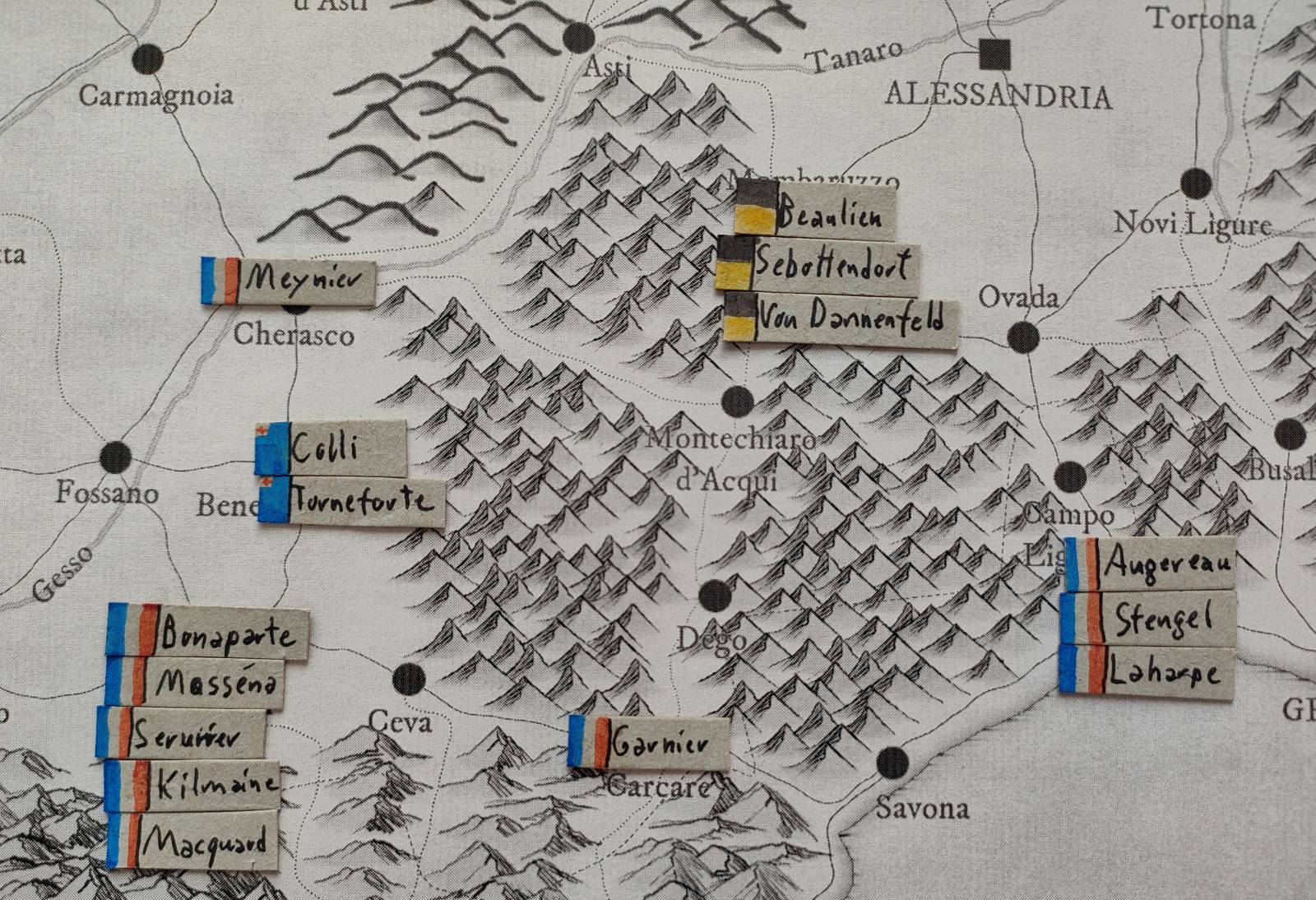
End of the campaign at the beginning of day 6. The Sardinians held against an attack at Bene Vagienne but severely reduced. Bremt has been wiped out by Meynier at Cheraso and the Sardinians are cut off. They will ask for peace. The Austrian force in the center looks menacing but is actually quite small. They have no chance to fight the French and have to retreat.
The battle mechanism needed some tweaking after that as well as the turn structure. Playing with open information was easy to do but not that much fun as it didn’t force tough decisions. I devised some rules for hidden forces and scouting from earlier iterations of campaign rules and started again.
Test Run 3
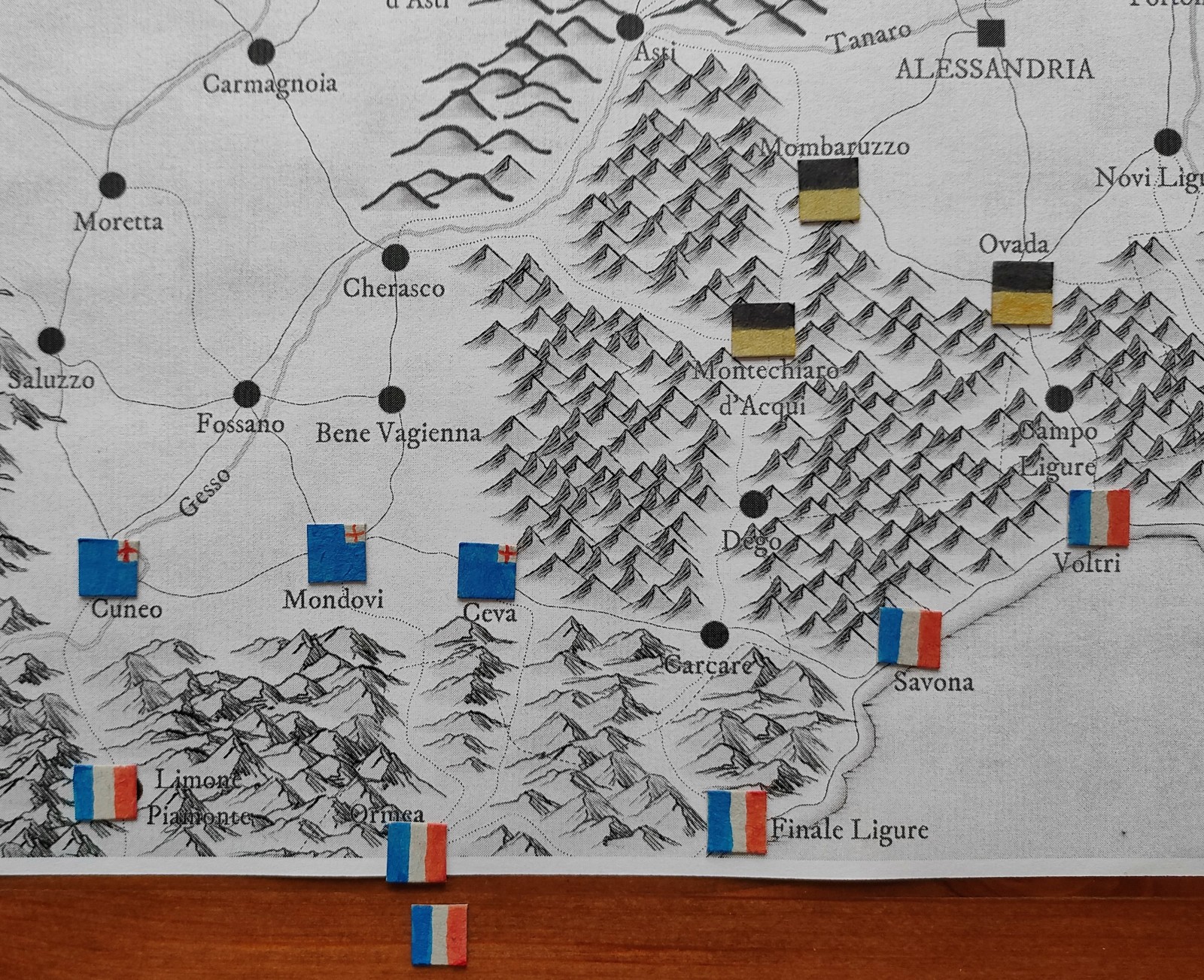
This time the setup rules are relaxed. Both sides know the total strength of the forces and where the enemy is but not its strength at any location.
The Allies are deployed close to the historical situation with Colli’s 20,000 on the Cunea-Ceva axis. 10,000 Austrians are in the center and 16,000 on the right.
The French have shifted divisions around a bit. Over 25,000 men are on the right, including the 5200 under Cervoni at Voltri. Their left is now stronger with Augereau’s big division of 10,000 men. At the center are another 12,000+ Frenchmen with 1,700 arriving on day 2.
Movement is hidden and resolved simultaneously with a chance of not obeying orders. A lot of rolls failed actually which led to a slow start.
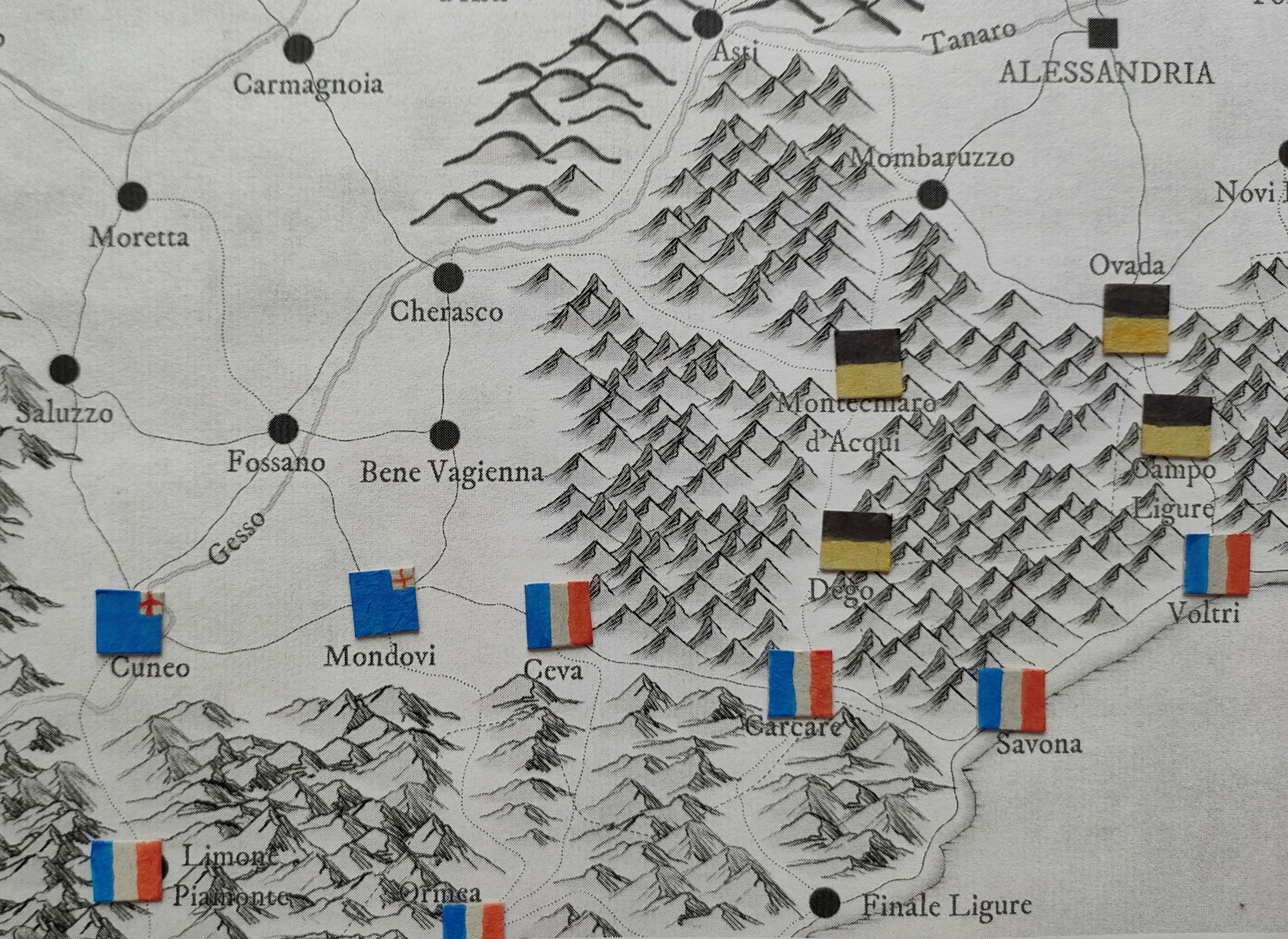
At the end of day 2 the French made slow advances. They beat a much smaller force at Ceva and also rebuffed a counter attack from Mondovi. The Austrians are making their way through the mountain passes. Scouting revealed no solid information but due to the battles both sides know that there are 12,000 to 15,000 men at Mondovi and Ceva each.
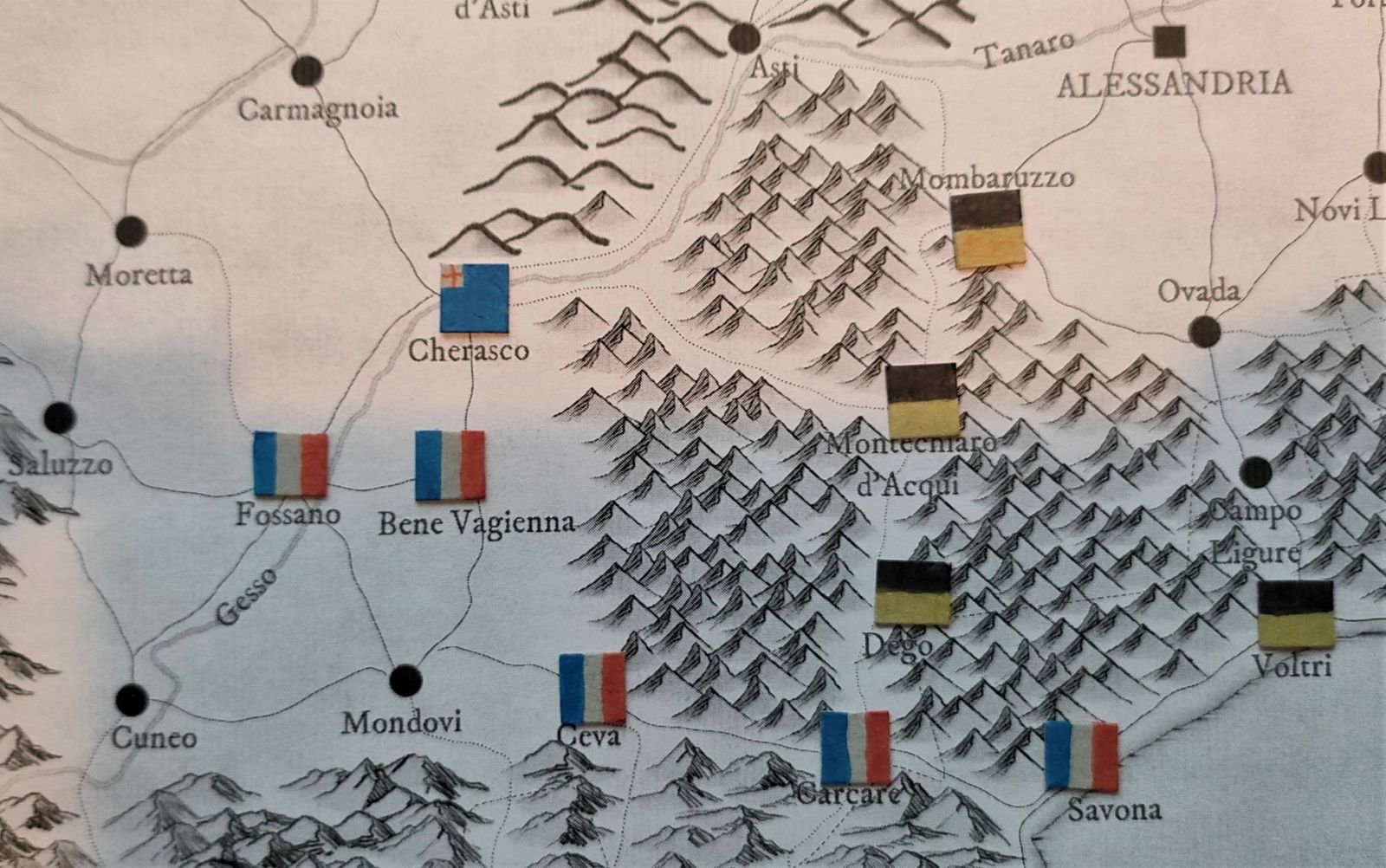
At the end of day 4 the situation looks bad for the Sardinian army. They failed to retire from Mondovi and their rearguard has been beaten with heavy losses on day 3. Colli has now consolidated his forces at Cherasco but his men are tired and demoralized. The Austrians won a battle at Voltri. Their scouting reveals the true French strength at Carcare (16,000 men). Together with information from Colli they can puzzle together the enemy strength at Savona. It is too high for an attack with the 9,000 men from Voltri.
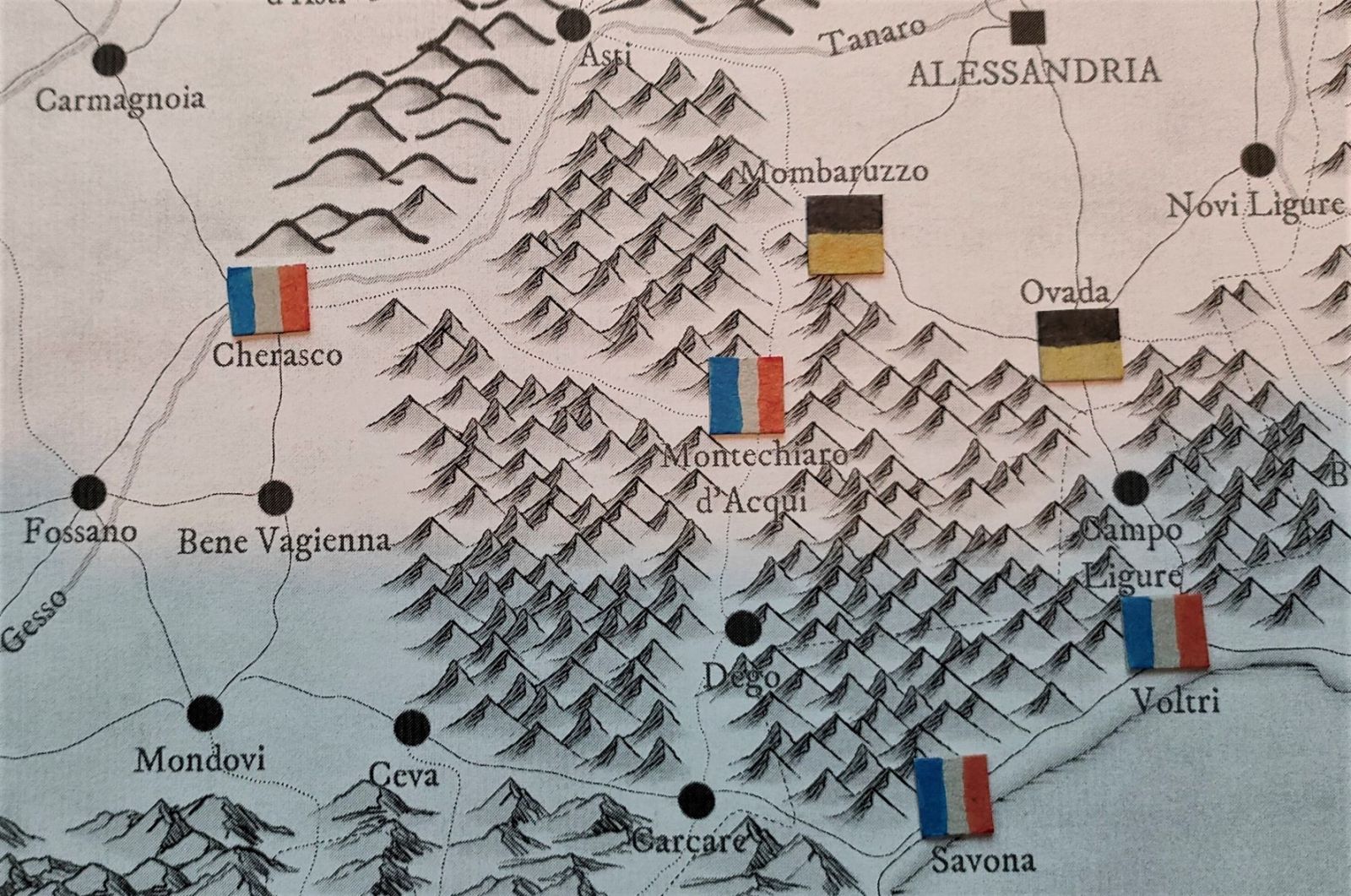
Another two days later. In the battle of Cherasco the remaining 10,000 Sardinian soldiers fought against 10,000 French under Augereau. The French won a minor victory but losses are too high to maintain for the Kingdom of Sardinia. They are out of the war. Augereau masses the remaining troops at Cherasco, numbering nearly 20,000 men still.
At Montechiaro d’Acqui Masséna lead his 12,000 strong army against 10,000 Austrains under Argenteau. Another Frnech win. Meanwhile, Napoleon takes the remaining 12,000 to the right flank and pushes Beaulieau’s 9,000 back to Ovada.

As Napoleon is slow to move up to Ovada at first, the Austrians try a daring maneuver. While Argenteau retires to Alessandria, Beaulieau advances to Mombaruzzo. But all the movement rolls for the French forces ordered to Mombaruzzo fail. Instead they advance to Alessandria and beat Argenteau back to Tortona. The gamble has failed and the Austrians have to recapture Alessandria.

After more days of maneuvering and several failed movement rolls the final big battle happens at Alessandria. Beaulieau’s entire army of 17,500 men against 18,000 lead by Augereau. The Austrians give a good show despite being tired and on the back foot for days. But The French win in the end and the campaign comes to a close with the capture of Alessandria.
Conclusion
The quick battle mechanism still needs some tweaking but worked well enough to keep the campaign flowing. Test run 3 gave me real problems and options to ponder. Hiding the strength of forces and making movement not entirely predictable were key factors in this.
The Allies already have their restrictions in place regarding movement, combat and deployment, which makes the campaign very difficult for them. I think this can be corrected by introducing easy supply mechanics for the French. But as the main goal is to produce battles test run 3 was a overwhelming success. Ten battles were simulated with only few having overwhelming odds for one side. I was particularly pleased to end with the biggest battle at the Alessandria node. Although Napoleon was not present for an very early Marengo.

Have you considered using, or lifting mechanics from, ‘The Generalship Game’ in ‘Napoleonic Wargaming for Fun’ by Paddy Griffith. It seems very close to what you’re trying to achieve. Also, have you got ‘Attack in the West’ by Maj WGF Jackson – IMO it’s hands down the best military appreciation of Bonaparte’s ’96 campaign. It’s all about achieving an advantage (usually in numbers) subject to the constraints of time and movement and absolutely chock full of maps and diagrams – almost one on every other page..
LikeLike
Thank you for your recommendation. ‘Attack in the West’ is unfortunately really hard to get. Regarding the mechanics: I’m more in the process of developing my own rules. The Generalship Game has influenced them, as have many other campaign rules. But the main focus will remain a quickly playable map game to produce tabletop battles.
LikeLike
Great read, but how did you O hidden movement? I am going to try a solitaire campaign set on the left flank of the grand armees 1812 Russian campaign.
LikeLike
There are different techniques I use. Sometimes I write several plans/maneuvers and decide randomly. This time however I only used flags on the game map with no indication of leaders or troop strength. I had lists for each side where the own troops were but also the intel they collected (by meeting the enemy in battle). Then I simply thought about what the commanders want to do and write orders for their troops. After all orders were written I moved the forces. Movement is not guaranteed which helps a lot in making the situation less predictable.
Good luck with your campaign. The French left flank 1812 is a interesting theater for a campaign.
LikeLike
Thanks for your reply,
You mentioned you had the force locations noted down though – so how did this work with also hidden movement ?
I was thinking that like the PC game campaigns on the Danube, maybe there is a way to do where I can only make decisions based on the info I receive back at the hq
LikeLike
The French have 3 divisions of 5,000 men each at location A. They write their movement orders in secret. When I look at the map from the Allied perspective all I see a French flag counter at location A. The Allies know there are French forces at location A but not how many and which. They also don’t know if they will move, split up or stay there. The Allies therefore have to write their own orders judging what the enemy can do, not what he will do. I, as the player, know that the French will move to location B with 10,000 men and leave 5,000 behind but the Allies do not know that. They have to take into account that the French will move to location B or C or stay put or that the French at location A are only a handful and it is better to ignore them.
After the first contacts the guesswork will be mostly replaced with solid information but that’s fine by me. Its similar to what I’m reading about the period: Scouting/or lack thereof leads to the decisive battle or battles in close succession.
LikeLike
Thanks, sorry I won’t hassle you any more after this – just one other question – you are playing this solitaire yes? Just that when you write that the french write their orders in secret, that sounds like their are other people involved – this I think is at the crux of what I want to understand how exactly are orders being “written in secret” if it is solitaire,vor is this not something you are meaning literally?
LikeLike
No worries Georg. I now see where the confusion stems from. Yes I play solo, there is no one else involved. But I’m so used to it that it is easy for me to change perspective. So by secret I mean, the Austrian side cannot see the French orders and vice versa. There are several techniques to help you with that, like sitting at the opposite side of the map or turning the map around when thinking from the perspective of one side. Another one is to have a general plan and stick to it instead of optimizing every single turn. Maybe my professional background helps me here, because I’m an analyst and used to thinking about information from different perspectives.
Other methods are described in the ‘Solo Wargaming Guide’ by William Sylvester which I can recommend for its wealth of ideas.
LikeLike
Thanks, that clarifies things. Yes I just got that solo wargaming book, and only started it but already good stuff in it and I think the riga-polotsk region of the 1812 campaign could work well with ideas in that book
I guess I just read your accounts and keen to know what exactly you are doing as it is a good model for my eventual plan ( currently i am creating all forces and scenery as 3mm paper miniature pieces – am still deciding what ruleset.to us : ESR, Polemos, Guard du Corps, GdB, Legacy of Glory, LaSalle, Dbn Napoleonics, Élan Deluxe,.Morale Napoléon,.Bataille Empire etc – admittedly I have become a bit addicted to collecting rulesets
LikeLike